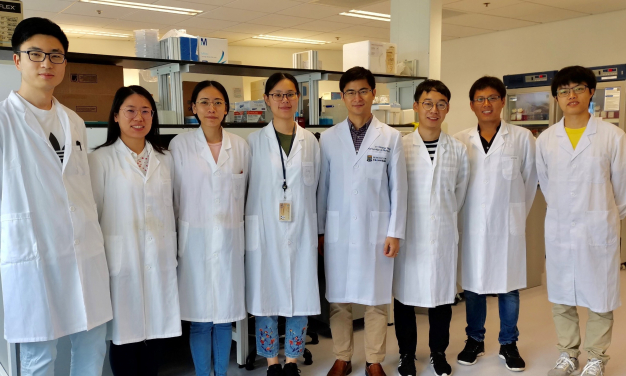Media
HKU develops a new strategy for the
photolysis of prodrugs at long wavelengths
30 Oct 2019
A research team from Dr Li Dak-Sum Research Centre and Department of Pharmacology and Pharmacy, LKS Faculty of Medicine (HKUMed), The University of Hong Kong, has achieved the photolysis of prodrugs at longer wavelengths than their absorption windows with an efficient one-photon strategy. This is attractive for medical applications since long-wavelength light has better tissue penetration and lower cytotoxicity. The research has just been published in Journal of the American Chemical Society, a preeminent journal in all of chemistry and interfacing areas of science (link to the publication), and a PCT application has been filed based on this work.
Background
Photolysis of photocleavable prodrugs can release free drugs at appropriate time points and locations with light excitation. Substantial efforts have been focused on increasing the excitation wavelength because long-wavelength light exhibits deeper tissue penetration depth and lower cytotoxicity. Photolysis at longer wavelengths than the absorption windows is currently achieved by multi-photon processes, including two-photon absorption and photon upconversion. These strategies require high-power lasers or multiple components to achieve the photolysis, limiting their biomedical applications.
Research methods and findings
The research team has found that a one-photon process can also achieve the photolysis with long-wavelength light instead of the current multi-photon strategies. The mechanism employs a suitable photosensitizer molecule, which allows for energy transfer to occur from the long-wavelength light-excitable photosensitizer to the photocleavable molecule. The transferred energy achieves the cleavage reaction and releases functional molecules. The process exhibits simplified energy-transfer steps compared with upconversion-based photolysis.
The proof-of-principle study was demonstrated using platinum (II) tetraphenyltetrabenzoporphyrin (PtTPBP) as the photosensitizer and a boron-dipyrromethene (BODIPY)-based prodrug as the photocleavable molecule. Normally, the prodrug can only be cleaved by green light. With PtTPBP, photolysis of the prodrug was achieved by low-power red LED light, which released free anticancer drug, chlorambucil. Another demonstration in the study shows an unexpected higher photolysis quantum yield than the direct excitation by green light.
Significance of the study
Photolysis of photocleavable molecules has been widely used in biochemistry, neurobiology, photoactivated chemical therapies and photoresponsive drug delivery. This study describes a new strategy for the photocleavage of photocleavable molecules using long-wavelength light. The strategy could be applied to other pairs of photosensitizers and photocleavable molecules for specific applications. The research opens a new path for achieving photolysis at long wavelengths, benefiting the applications in biological studies, photopharmacology and photoresponsive drug delivery.
About the research team
This study was led by Dr Weiping Wang, Assistant Professor of Dr Li Dak-Sum Research Centre and the Department of Pharmacology and Pharmacy, HKUMed. Dr Wen Lv, Post-doctoral Fellow of Dr Li Dak-Sum Research Centre is the first author of this work. Ms Yafei Li and Ms Yaming Zhang, PhD candidates of the Department of Pharmacology and Pharmacy, HKUMed, are co-authors. Other researchers are Professor David L. Phillips, Dr Xin Lan, and Dr Lili Du from the Department of Chemistry, HKU, and Professor Qiang Zhao and Mr Feiyang Li from the Key Laboratory for Organic Electronics and Information Displays and Jiangsu Key Laboratory for Biosensors, Nanjing University of Posts and Telecommunications.
Acknowledgements
This work was supported by Dr Li Dak-Sum Research Fund (Start-up Fund) of The University of Hong Kong, Seed Fund for Basic Research of The University of Hong Kong (No. 201711159053), Guangdong-Hong Kong Technology Cooperation Funding Scheme (No. 2017A050506016), and Young Scientists Fund of the National Natural Science Foundation of China (No. 81803469).
Media enquiries
Please contact LKS Faculty of Medicine of The University of Hong Kong by email ([email protected]).

